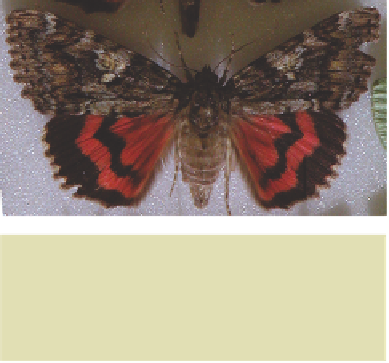Biology Reference
In-Depth Information
(1)
Adaptation or story telling?
Do the proposed adaptations of one party make functional
sense given the adaptations by the other party in the arms race? This is not a trivial
question. For example, Thayer (1909) suggested that flamingos are pink so as to
blend in with the setting sun, so that lions find them difficult to see in the evening
when out hunting. You may think this is an unlikely idea! But the proposal that
moths blend in with tree trunks or mimic bird droppings may be equally unlikely.
We need to perform experiments to test our hypotheses.
(2)
How can an arms race begin?
Prey cannot suddenly evolve perfect counter-adaptations
any more than a vertebrate could instantly evolve a perfect complex structure, such as
an eye. Our second question, therefore, is can even crude counter-adaptations decrease
predation pressure and thus serve as a starting point for an evolutionary arms race?
Two questions
about arms races
Predators versus cryptic prey
We begin by attempting to answer these two questions for one example of an arms race,
namely birds as predators of cryptic prey. Alexandra Pietrewicz and Alan Kamil (1979,
1981) studied underwing moths (
Catocala
spp) in the deciduous woods of North
America. There are up to 40 species living in a particular locality and they are hunted
extensively by birds, including blue jays and flycatchers.
Underwing moths
…
Testing hypotheses about adaptation
The forewings of the moths appear cryptic, looking very much like the bark of the trees
on which the moths rest (Fig. 4.3). The hindwings, on the other hand, are often strikingly
coloured yellow, orange, red or pink (Fig. 4.3). The moths rest with their forewings
covering the hindwings but when they are disturbed the hindwings are suddenly exposed.
Our hypotheses, therefore, are that the forewings decrease detection and the hindwings
may have a 'startle' effect on a predator that has found the moth, causing the bird to stop
momentarily and thus giving the moth time to escape.
… 'cryptic'
forewings and
'startling'
hindwings?
Cryptic forewings
In support of the crypsis hypothesis
for the forewings, different species
of underwing moths select different
backgrounds which match their own
colour and thus maximize the cryptic
effect. Furthermore, they orient
themselves in particular ways, so that the
wing patterns merge in with the fissure
patterns on the bark. Pietrewicz and
Kamil tested the importance of crypsis by
giving a slideshow to blue jays in an
aviary (Fig. 4.4a). Slides were projected
on a screen; in some cases there was a
moth present in the picture while in other
cases there was no moth. If there was
a moth, the jay was rewarded with a
Fig. 4.3
Underwing moths,
Catocala
spp., have cryptic forewings and
conspicuously coloured hind wings. This
is
C. sponsa
. Photo © Martin Stevens.






























